Red Gemstone Identification and Appraisal Guide
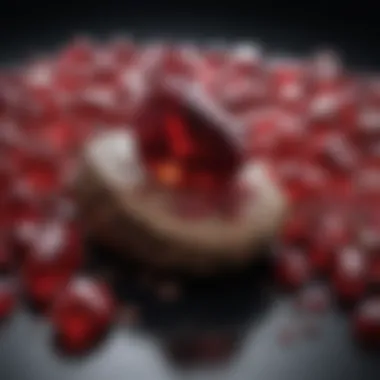
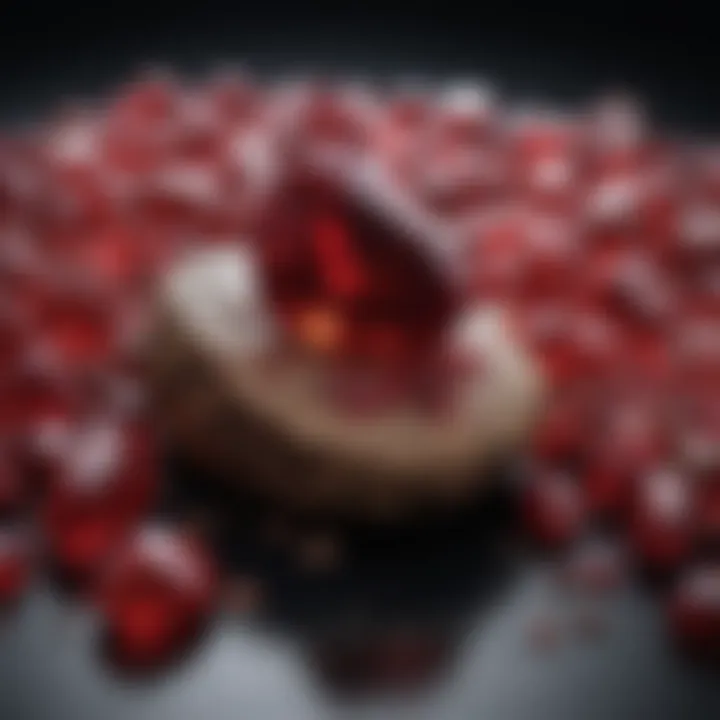
Intro
Red gemstones captivate enthusiasts and collectors alike with their striking colors and unique stories. From vibrant rubies to lesser-known varieties like garnets, the spectrum of red stones reveals a wealth of information worth knowing. Understanding how to identify and classify these gems can significantly enhance the collector's experience. Not only do these stones serve as adornments, but they also carry historical tales and geological marvels.
In this guide, we aim to equip you with tools for recognizing and valuing red gemstones. We will explore various identification techniques, delve into the characteristics that set these gems apart, and provide you with practical tips for evaluating authenticity and quality. This knowledge is indispensable, whether you are a seasoned collector or just embarking on your gemstone journey.
Featured Collectible of the Month
Overview
For our featured collectible this month, we shine a spotlight on the Spinel. Often overshadowed by more popular red gemstones, Spinel boasts a rich palette ranging from intense reds to vivid pinks. It has a crystalline structure that contributes to its brilliance and durability, making it a desirable choice among serious collectors.
Historical Significance
Historically, Spinel has often been mistaken for rubies or sapphires. One renowned example is the Black Prince's Ruby, a stunning deep red Spinel set in the British Imperial State Crown. This gemstone has an intriguing lineage, echoing tales of conquests and treasures. Many contemporary enthusiasts now appreciate Spinel for its unique qualities, distinct color variations, and its intriguing backstory further enhances its appeal amidst the gemstone community.
Identification Techniques
Identifying red gemstones can be a nuanced task, much like piecing together a puzzle. Collectors need to understand various visual and physical characteristics that define each type of stone.
Visual Characteristics
When it comes to red gemstones, the first thing that catches the eye is color; however, depth, tone, and saturation play crucial roles. Here are key visual factors to consider:
- Color Variations: Different gems offer various shades of red. For instance, rubies present a vivid red while garnets could span from red to purplish tones.
- Clarity and Inclusions: Observe clarity levels through the naked eye and with magnification. While some gems feature no inclusions, others like garnets often contain distinctive internal features.
- Cut and Shape: The way a gem is cut drastically influences its appearance. A well-cut ruby may reflect light beautifully, highlighting its internal qualities.
Resources for Identification
To aid in identifying red gemstones, several resources can be invaluable:
- Gemology Institutes: Institutions like the Gemological Institute of America provide comprehensive gem identification guides.
- Books on Gemstones: Suggested readings include "Gemstones: Detecting and Identifying" which serves as an excellent reference point.
- Online Communities: Engage with others on platforms like reddit.com to share your insights and learn from seasoned collectors.
Ultimately, the journey of identifying red gemstones combines observation, knowledge, and experience. By honing your skills and tapping into available resources, you can deepen your understanding of these captivating stones, ensuring a richer collecting experience.
Understanding Gemstone Classification
Gemstone classification serves as the backbone of the gemological world. It not only provides a framework for identifying stones but also enhances our understanding of their characteristics and value. Without this classification, enthusiasts and collectors might find themselves lost among the myriad of options available in the market. Each gemstone, including the striking red varieties, comes with unique traits that contribute to its allure and desirability. Knowing how to effectively classify these gems is vital for anyone who seeks to appreciate their beauty or invest in them.
One significant aspect of understanding gemstone classification is how it helps in verifying authenticity. As the market is flooded with both natural and synthetic stones, collectors must be equipped with the knowledge to distinguish between the two. This comprehension leads to informed purchasing decisions, ensuring that buyers are not hoodwinked by any cleverly disguised imitations. Not only does classification inform us about the stones’ provenance, but it also gives context to their history, rarity, and financial value.
Additionally, recognizing the criteria used for classification enables enthusiasts to appreciate the storytelling aspect of gemstones. These stories are often interwoven with cultural symbolism, historical significance, and natural formation processes, enriching the exciting journey of gemstone collection. Ultimately, a well-rounded grasp on classification lays the groundwork for deeper exploration into specific gemstones later in the article.
The Basics of Gem Classification
Gem classification typically revolves around a set of fundamental criteria, which include composition, crystal structure, and optical properties. The first element, composition, is about the chemical and mineral makeup of the stone. For example, rubies are compositions of corundum with traces of chromium; this means a gemologist must analyze the stone to determine its exact mineral content.
Crystal structure comes next, which refers to the arrangement of atoms within the gem. Stones with similar structures often share properties like hardness and clarity. For instance, both rubies and sapphires belong to the corundum family but differ in color due to the presence of different trace elements.
Finally, optical properties like luster, transparency, and color play a crucial role in classification. Rubies stand out due to their deep red hue and brilliance, while garnets can display a wide range of colors including vibrant reds and subtle pinks.
Being aware of these basics aids collectors in determining not just the type but also the value of a gemstone based on its unique characteristics.
Differences Between Precious and Semi-Precious Stones
The distinction between precious and semi-precious stones is foundational in the world of gems. Although they both serve decorative and adornment purposes, they vary greatly in rarity and value. Traditionally, precious stones are considered the more exclusive category comprising diamonds, rubies, sapphires, and emeralds. These gems are not only rare but also hold significant market value due to their impeccable quality and universal desirability.
On the other hand, semi-precious stones include a broader range of gemstones like garnets, tourmalines, and amethysts. While these can also be stunning and high-quality, they are generally more accessible in terms of availability and price.
"It’s essential to understand that the classification into 'precious' and 'semi-precious' is often subjective and can change based on market trends, demand, and personal perception."
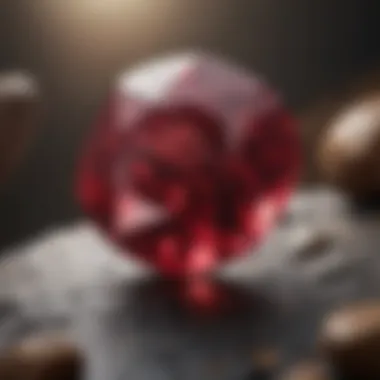
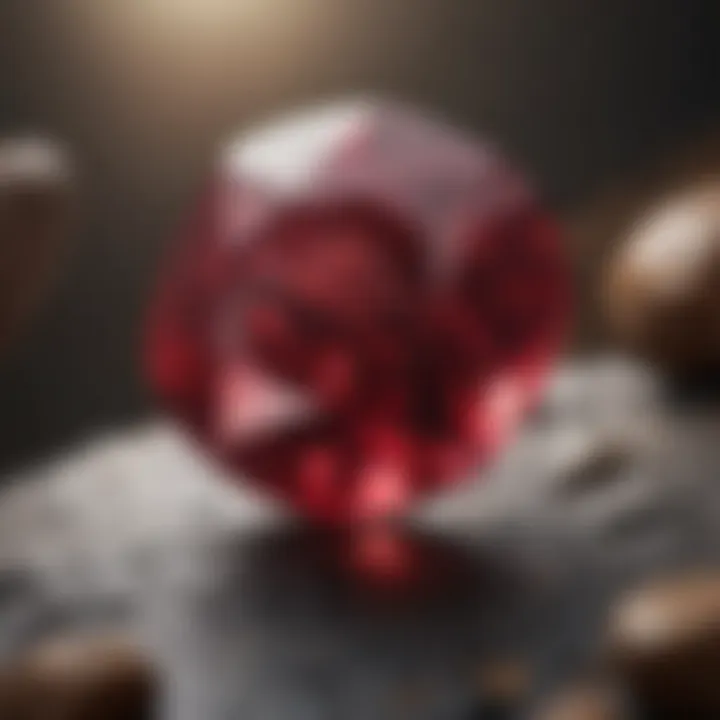
For collectors, recognizing these differences can shape their investments and influence choices about purchasing and setting. Some collectors prefer to invest in the more exclusive precious stones, while others appreciate the vibrancy and unique characteristics of semi-precious varieties. Either way, understanding these classifications adds another layer of comprehension in the journey of gemstone identification.
A Focus on Red Gemstones
When exploring the realm of gemstones, red stones often command attention, drawing the gaze of jewellers and collectors alike. Red gemstones are not just visually striking; they possess a rich tapestry of history, culture, and science woven tightly together. Their various shades and characteristics can be both captivating and confusing, making the understanding of red gemstones a topic of great relevance in this article.
The depth of appreciation for red gemstones can largely be attributed to their historical significance and cultural symbolism. For instance, throughout the ages, red stones have been perceived as symbols of power and passion. From the regal use in crowns and royal insignia to their role in intricate jewelry crafted for the elite, red gemstones such as rubies and garnets have often been associated with wealth and nobility. This powerful symbolism continues to resonate in modern times, giving enthusiasts and collectors compelling reasons to delve deeper into their significance.
Additionally, there’s the practical side of identifying these gemstones—an endeavor that requires understanding not just their beauty but also their unique properties. Color, clarity, and the geographical origins of red gemstones can tell stories that date back centuries. Knowing how to differentiate between various types of red stones enriches the collector’s experience and aids in assessments of authenticity and value. A focus on red gemstones serves as a gateway to grasping the essential techniques for identification, which ultimately leads to informed purchasing decisions.
Crafting a nuanced understanding requires examining the historical journey of these exceptional stones, their significance across time, and their symbolic attributes in varying cultures.
"Understanding the legacy of red gemstones is vital to appreciate their present significance."
Historical Significance of Red Gemstones
Red gemstones have a storied past, deeply entrenched in cultures worldwide. The allure of rubies, which are often regarded as the kings of gemstones, can be traced back to their use in ancient royalty and religious artifacts. Ancient texts speak of rubies enriching the crowns of monarchs and the adornments of deities in temples. The belief that rubies could bestow power, protection, and passion solidified their place in the annals of history.
Moreover, garnets have roots embedded in ancient civilizations, making their way from the Egyptian tombs to the battlefields of the Middle Ages. Soldiers wore garnets, believing they would render them invincible, while traders prized them for their mystical properties. This fascinating historical context not only adds value to these stones but also opens a dialogue about their evolution through various eras and cultures.
Cultural Symbolism Across Civilizations
From the ashes of ancient tribes to the luxuriant courts of modern-day societies, red gemstones have symbolized a plethora of concepts across civilizations. In many cultures, they are seen as a symbol of love, lifeblood, and passion. For example, in Indian culture, rubies are often associated with the sun, representing prosperity, passion, and the warrior spirit. In contrast, the ancient Greeks associated red stones with the power of love and as an aphrodisiac, using them to attract lovers.
Various cultures have imbued red gemstones with ritualistic purposes as well. In medieval Europe, they were commonly embedded in jewelry to ward off misfortune. The Peruvian Incas, notably, revered garnets, weaving them into ceremonial garb and using them in significant rituals. Understanding these cultural intricacies provides collectors with deeper insights into the stones they possess. It connects the physical object to a larger tapestry of human experience and interpretation, enriching the value of each piece in a collection.
Recognizing the historical and cultural significance shapes a more respectful and informed approach to gemology and collection. With each pair of eyes that gazes upon a red gemstone, there lies not just the allure of beauty but a profound story waiting to be told.
Key Characteristics for Identification
When it comes to identifying red gemstones, certain key characteristics serve as the cornerstone of effective evaluation. Understanding these details not only aids in distinguishing between different types of gemstones but also plays a vital role in assessing their quality and authenticity. For collectors, possession of detailed knowledge about these features can set one apart from the casual onlooker. Recognizing the subtleties in color, clarity, and hardness can immensely enhance the collecting experience and investment value.
Color Variations and Importance
Color is arguably the most recognizable characteristic of red gemstones. Each type radiates its own unique shades, ranging from the deep, romantic crimson of rubies to the vibrant, fiery hues of garnets. However, it’s not just about identifying a color on a color wheel; it’s about discerning the specific tone, hue, and saturation that define a particular stone.
For instance, rubies can display a remarkable range of red hues, from cherry red to a more purplish red, known as purplish or pinkish red. The intensity and overall quality of color can heavily influence a gemstone’s value. A finer ruby with an intense, uniform red color could fetch significantly more than a similarly sized stone with mixed or dull tones. Collectors must therefore appreciate these subtle variations as they relate to market desirability.
"Color is the first step in understanding the story behind each gemstone."
Clarity and Transparency Factors
Clarity refers to how clear or included the stone is. This characteristic can range from flawless to heavily included. Red gemstones like rubies often have natural inclusions known as "silk," which are needle-like rutile crystals that can enhance their value under certain conditions.
When analyzing clarity, it’s crucial to consider how inclusions affect light passing through the gemstone. A clear garnet may reflect light brilliantly, while one with cloudy areas can appear lackluster. Various grades of clarity exist, and understanding these degrees plays a vital role in the appraisal process. For those who appreciate gemstone aesthetics, clarity significantly contributes to the visual allure of a stone.
Understanding Gemstone Hardness
Hardness is a critical attribute in vice and value. The Mohs scale, ranging from 1 (talc) to 10 (diamond), is commonly used for this purpose. Most red gemstones fall between 6.5 and 9 on this scale, making them suitable for daily wear. Rubies, for instance, boast a hardness of 9, rendering them almost impervious to scratches. This durability is a major selling point, especially for those interested in jewelry that can withstand the rigors of daily life.
Garnets, while slightly softer than rubies, can still be incredibly resilient. However, one must be cautious of softer varieties if purchasing for frequent use. Understanding hardness helps collectors not just in determining practical uses for their gemstones, but also in recognizing the intrinsic value tied to durability.
In summary, these key characteristics of color, clarity, and hardness are intrinsically linked to the broader theme of identification. Collectors who arm themselves with this knowledge are better equipped to navigate the captivating world of red gemstones, making informed decisions that resonate with both passion and prudence.
Common Types of Red Gemstones
Understanding the common types of red gemstones is essential for enthusiasts, collectors, and even those simply curious about the vibrant world of gems. Each type of red stone has its unqiue properties, historical significance, and appeal, making them not just beautiful adornments but also valuable collectibles. The meticulous identification of these stones can elevate appreciation from mere admiration to knowledgeable ownership.
Rubies: Corundum's Finest
Rubies, often deemed the kings of red gemstones, boast a color that ranges from pinkish hues to deep, blood-like red shades. Derived from the mineral corundum, the quality of a ruby hinges on its color, clarity, and cut. The finest rubies exhibit a rich red tone known as "pigeon's blood," a term that evokes an intense and vivid allure.
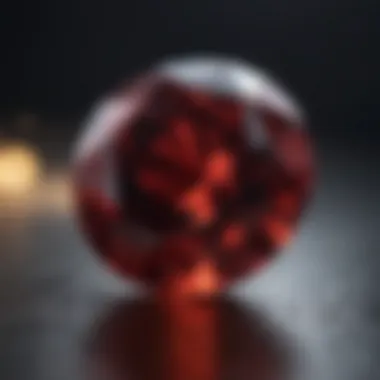
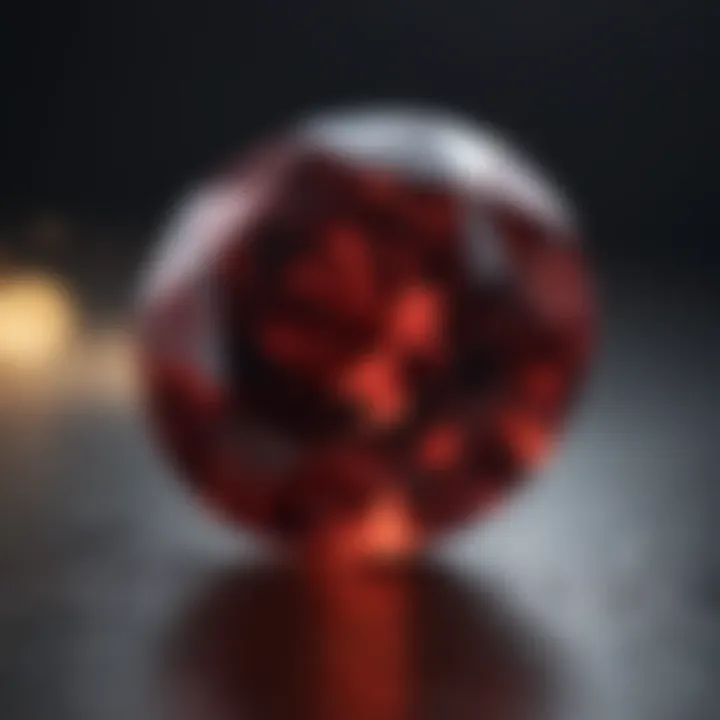
Notably, rubies are second only to diamonds in hardness, making them durable gemstones suitable for all types of jewelry. Furthermore, their rarity adds a significant layer of value."
"The awe of a ruby isn't merely in its color; it's in its journey from the Earth to the jewelers' hands."
When considering rubies, it's vital to keep an eye out for enhancement treatments. While heat treatment is common and acceptable, those adorned with glass fillers might not hold their value. Collectors should familiarize themselves with reputable dealers to ensure they are acquiring genuine stones.
Garnets: A Complex Family
Contrary to popular belief, garnets encompass a wide variety of minerals, with red being the most recognized subset. These gemstones come together in various types, each with distinct qualities. For instance, almandine garnets exhibit a deep red color reminiscent of a fine wine, while pyrope garnets may lean towards a more sanguine shade.
Garnets are notable for their historical significance, once regarded as protective talismans for travelers. Their unique internal structures and perfect cleavage make differentiating between the types quite fascinating. The ability of garnets to shift in color based on light and surroundings only adds to their complex allure.
Spessartite and Other Garnets
Spessartite garnets stand out among their garnet counterparts due to their distinctly orange-red hues. Initially overshadowed by the more well-known garnet varieties, spessartites have surged in popularity due to their vibrant color and clarity. They can be somewhat rare, particularly in larger sizes, which adds to their desirability.
While collectible, it's important to be aware of treatment processes that might alter the appearance of spessartite. High-quality stones can fetch impressive prices in the market, reflecting their growing recognition among collectors.
Keeping connections to gem shows and auctions can often yield opportunities to snag these beautiful specimens.
Red Tourmaline: The Variety and Color Range
Red tourmaline, or "rubellite," is another fascinating member of the gemstone family. Its color spectrum varies widely, from soft pinks to deep, vivid reds. Tourmaline’s pleochroism—where its color changes based on the angle of view—fuels its captivating reputation. This quality makes every piece somewhat unique.
Furthermore, red tourmaline is less traditional than rubies but holds its own in regards to beauty and charm. It's more approachable in the pricing department, appealing to collectors who appreciate both aesthetic and fiscal sensibility. When scouting for red tourmaline, a focus on clarity and saturation can lead to finding exceptional stones that stand out in any collection.
In summary, each type of red gemstone carries not only its specific characteristics but also a rich tapestry of history and meaning. Understanding these elements aids in making knowledgeable choices for collection and appreciation. Whether investing or simply enriching personal adornments, knowledge is an invaluable companion.
Advanced Identification Techniques
The exploration of advanced identification techniques stands as a cornerstone in the field of gemology, especially when dealing with the rich tapestry that red gemstones present. Understanding these methods is vital for differentiating between genuine stones and imitations, as well as assessing their unique qualities. For collectors, the implications are profound: knowledge of these techniques can directly influence the value and authenticity of their prized possessions. Notably, the methods employed not only enhance the collector's appreciation of the gemstone but also confirm its provenance and quality.
Using Spectroscopy for Analysis
Spectroscopy serves as a powerful tool in the gemologist's kit, allowing for the detailed analysis of a gemstone's composition and structure. By examining how a gemstone interacts with light, spectroscopic techniques can reveal distinct absorption patterns that aid in identifying the material's specific elements. There are several types of spectroscopy, such as visible light spectroscopy and infrared spectroscopy.
For instance, consider a ruby: when subjected to visible light spectroscopy, it will exhibit a unique absorption spectrum that differentiates it from similar stones like garnet or red tourmaline. This method shines especially bright in identifying chemical impurities within the gemstone which can provide clues about its origin. In practical terms, using spectroscopy is not just an academic exercise. It’s a critical step for collectors wanting to gain confidence in their acquisitions. If a ruby has distinct absorption lines corresponding to chromium, evidenced specifically in its spectrum, it is a reliable indicator of its authenticity.
"The nuances of a ruby's spectrum can unlock mysteries of not just its color, but its entire geological journey."
Microscopic Examination Methods
Alongside spectroscopy, microscopic examination methods play a pivotal role in gem identification. These methods allow for a closer look at a gemstone’s internal structure and surface features. By employing high-powered microscopes, gemologists can observe characteristics such as inclusions, growth lines, and even surface treatments.
For example, under magnification, the presence of silk inclusions in a garnet can indicate its natural origin. Chemically modified or synthetic stones may lack such features, presenting more of a uniform appearance that can raise eyebrows when compared to a natural gem. Collectors should consider keeping a loupe handy for their explorations. This small tool can reveal fascinating details that speak volumes about a gem's identity.
Combining microscopic examination with spectroscopy creates a layered approach that enhances accuracy in identification. Identifying these characteristics not only bolsters the credibility of the stone but also opens discussions surrounding its market value, provenance, and collectibility.
In summary, utilizing advanced identification techniques like spectroscopy and microscopic examination empowers collectors to navigate the intricate world of red gemstones with clarity and confidence. Whether it’s determining authenticity or appraising value, these methods are essential tools that every bone collector should familiarize themselves with to make informed decisions.
The Role of Gemstone Appraisal
Gemstone appraisal plays a vital role in the world of gemstones, particularly when dealing with precious and semi-precious stones like rubies, garnets, and tourmalines. It serves as a bridge, linking the intrinsic characteristics of gemstones to their market value. Appraisal is not merely a checklist to determine worth; it's an intricate process that considers numerous parameters that contribute to a gemstone's appeal.
First and foremost, understanding the nuances of quality and value is critical, especially for those looking to invest. Appraisals incorporate aspects such as color, clarity, cut, and carat weight, commonly known as the "Four Cs." Each element carries its weight in determining how a stone will perform in the marketplace, making this evaluation essential for collectors, traders, and even casual buyers. It’s about painting a full picture of the gem's quality in addition to its monetary value.
Moreover, an appraisal isn't static; the gemstone market is constantly evolving. What was seen as a top-tier gem yesterday may lose its sheen tomorrow based on shifts in collector demand or geological discoveries. Hence, having a qualified appraiser can help keep collectors informed about present market trends and potential future values.
In essence, a thorough appraisal not only helps in making informed purchasing decisions but also plays a pivotal role in insurance evaluations and resale potential. Without it, one might navigate this colorful yet complex domain without a reliable compass.
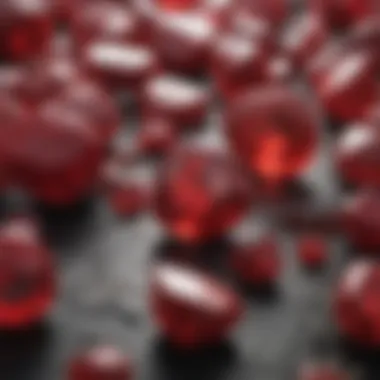
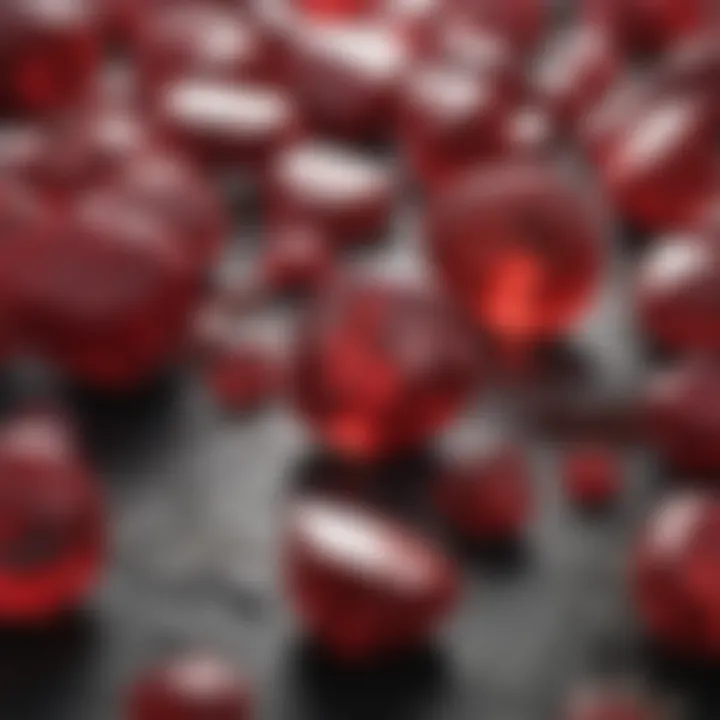
"A gemstone is not just a shiny rock; it’s its own story, waiting to be told through an accurate appraisal."
Evaluating Quality and Value
When it comes to evaluating quality and value, each gemstone carries unique identifiers. For instance, rubies often hold a high value due to their rich saturation and rarity. Knowing how to evaluate these stones requires understanding the specifics of each type. A trained appraiser will assess the gem’s hue, saturation, and tone. This method not only helps to determine the quality but also provides insight into the likelihood of appreciation over time.
On the other hand, garnets display a spectrum of colors that can vary in demand. The deep red variety is often prized, yet color alone does not determine value. Factors like origin and any treatments the stone has undergone—like heat treatment or dyeing—also significantly affect its market performance.
Key Evaluation Factors:
- Color: Which hue the stone displays and how pure or vivid it appears.
- Clarity: The presence of inclusions and how they affect the overall beauty of the stone.
- Cut: How well the stone has been cut and shaped can enhance its brilliance and value.
- Carat Weight: The size of the stone also impacts price, with larger stones often commanding higher values.
With a balanced evaluation carried out by a knowledgeable appraiser, collectors can make choices grounded in not just appearance but also financial foresight.
Market Trends and Demand Factors
The market for gemstones isn't stagnant; it ebbs and flows like the tide. This ever-changing landscape influences how red gemstones are perceived and valued. Market trends can be driven by various factors, including fashion, celebrity endorsements, and even changing cultural perceptions.
Currently, the resurgence of vintage styles is breathing new life into ruby and garnet demand. As skilled artisans ramp up production of unique, handcrafted jewelry, these red stones are becoming must-haves. On the other hand, technological advancements in treatments and synthetics can impact how natural stones are valued.
Consider some of the elements that contribute to market trends:
- Cultural Events: Major holidays, weddings, and even film releases can spike interest in specific gemstones.
- Economic Conditions: A booming economy often sees collectors more willing to invest in higher-end stones, while recessions can lead to a focus on more affordable options.
- Environmental Awareness: Growing concern about ethically sourced stones is pushing buyers toward certified, natural gemstones over synthetic alternatives.
Understanding these market dynamics will empower collectors to navigate their investments wisely, ensuring they make informed decisions aligned with current trends and future potential.
The identification of red gemstones can be quite the labyrinth for both seasoned collectors and newcomers alike. This venture goes beyond merely distinguishing between various shades of crimson. The nuances in clarity, cut, and even cosmic phenomena all play into the puzzle of authenticity. Recognizing these challenges paves a path for understanding the deeper properties of these gems and helps prevent costly mistakes, elevating both collecting practices and knowledge.
Synthetic vs. Natural Gemstones
A prominent challenge in the world of gemstones is identifying the difference between synthetic and natural stones. Synthetic gemstones, like lab-created rubies, often mimic the appearance of their natural counterparts. They can boast clarity and color enhancements that nature simply does not produce. The key to telling them apart lies in several factors:
- Inclusions: Natural gems usually have unique inclusions or imperfections formed over millions of years. Synthetic stones, however, might show bubbles or patterns that are uniform and recognizable to trained eyes.
- Growth Patterns: These can often reveal the history of a stone. For instance, natural stones tend to have irregular growth, while synthetic ones might display striations common in lab settings.
- Spectroscopic Analysis: Using advanced techniques like spectroscopy can help unmask the composition of a stone, as synthetics often contain trace elements not typically found in nature.
Navigating this synthetic-natural tension is crucial, as many consumers might not realize they are purchasing a lab-grown gem at natural gem prices. Educating oneself on these differences not only enriches understanding but also enhances the quality and value of one’s collection.
B Degree of Treatment and Enhancement
Another intricate layer to gemstone identification is understanding the extent of treatment and enhancements that red gemstones often undergo. Treatment often improves a gemstone's appearance but can complicate the identification process:
- Heat Treatment: Common among rubies to enhance color and clarity. Collectors must ascertain whether the ruby they possess has been treated. If so, it affects the value significantly.
- Fracture Filling: This is typically done to fill cracks in gemstones, improving their visual appeal. Knowledge of how to detect these treatments— through microscopic examination—empowers collectors to make informed decisions.
- Surface Coating: Some stones are coated to heighten color. Although this might look appealing at first sight, it may diminish over time, revealing a subpar appearance.
To illustrate this, consider a vivid red tourmaline that has undergone aggressive treatment compared to a more muted natural version. While the treated stone might draw your eye initially, prolonged ownership could reveal its flaws:
"The most beautiful gem does not always reflect its true worth. Understanding treatment is as important as recognizing a gem's inherent beauty."
In sum, the significance of understanding the challenges in identifying red gemstones cannot be overstated. Awareness of what sets apart natural from synthetic, and untreated from treated gemstones fortifies the knowledge base of collectors. Opportunities for rich insights and sound investments lie in this intricate landscape.
Collecting Red Gemstones
The world of red gemstones is not just about their allure and aesthetic appeal; it’s a captivating journey for collectors. Engaging in collecting red gemstones opens a door to understanding geology, history, and artistry. Each stone carries a unique story, making the pursuit of these radiant gems an enriching experience that goes beyond mere ownership.
Focused Strategies for Collectors
When embarking on the adventure of collecting red gemstones, having a focused strategy is essential. Here are several key points that can guide collectors in refining their collection:
- Research and Education: Knowledge is power. Understanding the different types of red gemstones, such as rubies, garnets, and red tourmalines, can greatly enhance your collecting experience. Don’t hesitate to devour books, online courses, and reputable websites.
- Attend Gem Shows and Auctions: These events are like treasure troves! Not only can collectors inspect high-quality stones up close, but they also provide an opportunity to network with other enthusiasts and professionals. Take note: asking questions can lead to valuable insights.
- Join a Local Gem and Mineral Club: This is a gateway to a community of like-minded individuals. Clubs often organize field trips, guest speakers, and educational sessions. Plus, you can find mentors who’ve been in the game much longer.
- Use Online Marketplaces Wisely: Websites like eBay and Etsy can be goldmines for unique finds. However, caution is key. Always check seller ratings and reviews before making a purchase to avoid unpleasant surprises.
- Document Your Collection: Keeping a journal or database of your gemstones is a clever way to track what you own, their origins, and any significant features. This not only helps in maintaining your collection but also provides insights should you decide to sell or trade in the future.
"Collecting gemstones is not just about gathering objects; it’s about preserving a slice of nature’s art!"
Resources for Education and Networking
The journey of collecting red gemstones is deeply supported by various resources. Here is where you can dip your toes in knowledge and connection:
- Books and Literature: Authoritative texts like "Gem Identification Made Easy" can serve as excellent references. These resources can help you identify the unique traits of different stones.
- Online Forums and Reddit Communities: Engaging in discussions in places like Reddit can be enlightening. Subreddits such as r/gems and r/crystalcollectors offer a platform to ask questions, share your find, and get feedback from seasoned collectors.
- Local Museums and Gemology Schools: Museums frequently hold exhibitions showcasing various gemstones. Enrolling in short courses at gemology schools can also offer formal education and hands-on experience.
- Social Media Groups: Platforms like Facebook host numerous groups where collectors share their collections and experiences. Joining these communities establishes a great network and opens discussions on trends, trades, and tips.
Being part of a collecting community not only enhances the experience but can also spark friendships and mentorships that can last a lifetime. Whether you’re digging through piles at a show or browsing online, the journey of collecting red gemstones is as valuable as the stones themselves.



